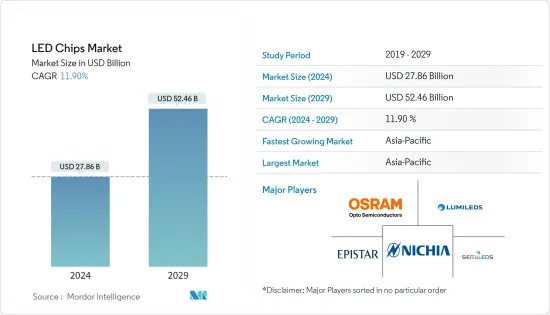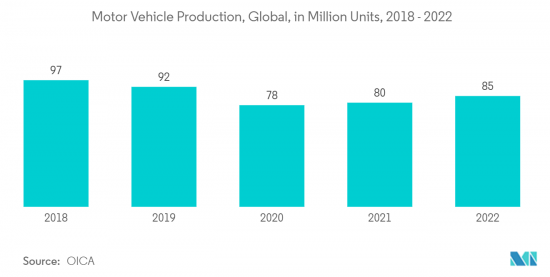 |
市場調查報告書
商品編碼
1404417
LED 晶片:市場佔有率分析、行業趨勢和統計、2024-2029 年成長預測LED Chips - Market Share Analysis, Industry Trends & Statistics, Growth Forecasts 2024 - 2029 |
||||||
※ 本網頁內容可能與最新版本有所差異。詳細情況請與我們聯繫。
LED晶片市場規模預計到2024年為278.6億美元,預計到2029年將達到524.6億美元,在預測期內(2024-2029年)複合年成長率為11.90%。

對成本、節能照明和各種其他因素的需求增加正在推動對 LED 晶片的需求。因此,LED晶片市場的許多新興市場旨在提供更有效率、更先進、亮度更高、功耗更低的產品。
主要亮點
- 汽車產業無論在內部或外部都處於採用 LED 照明的前沿。艾邁斯歐司朗是一家領先的照明製造商,也是汽車行業照明生產的先驅,為多家製造商提供照明設備。 3D 列印的出現幫助供應商減輕了汽車模組的重量。然而,此類應用僅限於豪華汽車。
- 此外,LEDinside最近的報告指出,Micro LED技術在亮度和對比度方面比OLED具有更優異的表現,且反應時間快、功耗低、可靠性高,適合移動和汽車應用,是最佳選擇。考慮到這些趨勢,廠商正在加大對Micro LED生產的投資。例如,2023年4月,LED解決方案提供商友達光電宣布計劃將其位於台灣的LCD 5A工廠改建為Micro LED生產線。該公司表示,新生產線預計將於 2025 年運作,並將瞄準穿戴式顯示器、電視和指示牌顯示器以及汽車顯示器等應用。
- 印度政府最近批准了在全國範圍內向各種最終用戶推出低成本 LED 的計劃。據印度政府稱,LED的實施每年將節省超過33.5億度的能源,並避免超過6,725兆瓦的尖峰需求。因此,這種趨勢預計將增加國內LED晶片製造的投資。
- 此外,LED晶片全球成長的另一個主要動力是漁業、醫療、海洋、園藝和港口照明等LED利基照明的進步。 LED晶片擴大用於標誌和訊號。它們依靠太陽能或電力運行,可用於控制十字路口的車輛和行人交通。標誌和號誌燈採用 LED 技術,功耗低。
- 公司不斷投資新產品,以增加 LED 在高階應用的使用。 2022年4月,艾邁斯歐司朗宣布投資8.5億美元擴建位於馬來西亞居林的LED生產工廠。該新廠將生產8吋晶圓上的LED晶片和micro LED晶片。
- 然而,LED 晶片對熱很敏感,這會降低效率和壽命,特別是在工業單位和製造工廠。
- 此外,俄羅斯和烏克蘭之間持續的衝突可能會對電子產業產生重大影響。衝突已經加劇了半導體和能源領域的供應鏈問題,晶片短缺已經影響了這個產業。這種破壞可能導致必要原料的價格不穩定並導致材料短缺。此外,由於中國是LED晶片的主要供應國之一,美國之間的貿易爭端預計也會影響研究市場的成長。
LED晶片市場趨勢
汽車預計將佔據主要市場佔有率
- 全球汽車製造業不斷崛起,也對汽車照明產業產生了正面影響。由於燃料成本降低和有害環境排放減少,電動車產量的增加對汽車照明市場的收益產生了重大影響。隨著救護車和警車越來越依賴照明系統來發出訊號,對高品質汽車照明解決方案的需求也不斷增加。此外,政府有關道路安全的法規也促使汽車製造商採用 LED 等高品質照明解決方案。
- 根據中國中央政府預測,2025年,中國汽車產量預計將達到3,500萬輛。隨著汽車產量的增加,對LED晶片的需求預計也會增加,這反過來預計將對研究市場的成長產生積極影響。
- 同樣,全球汽車產量的增加將帶動汽車LED晶片的需求。例如,根據 OICA 的數據,2022 年全球將生產約 8,500 萬輛汽車。這個數字與前一年同期比較增加了約6%。
- 考慮到需求的成長,供應商正在提出創新的解決方案。例如,2022 年初,艾邁斯歐司朗推出了用於汽車前照明的最亮 LED。 Oslon Black Flat X 在 1A 電流下可提供 460 流明,有 1 頭和 2 頭兩種型號。到 2022 年中期,該系列將加入各種多晶片變體,使車頭燈製造商能夠創建經濟高效的 LED 頭燈設計。這樣的市場開拓預計將進一步推動研究市場的成長。
- LED燈主要消耗的動力僅為白熾燈的十分之一。因此,歐盟 (EU) 已正式認可 LED 頭燈具有節能性。這就是歐司朗等公司為汽車產業提供各種 LED 的原因。例如,奧迪在其新款奧迪 A8 車型的車頭燈中使用了歐司朗 LED。對於普通照明,歐司朗提供幾乎所有從 0.1W 到 5W 的 SMD LED,採用各種尺寸的封裝:3030、5050、5630、2835。

預計亞太地區成長率最高
- 亞太地區對家電和汽車的需求旺盛,由於科技的快速創新,這些產品也變得越來越複雜。因此,對高功率和中功率LED 的需求預計將會增加。鑑於可支配收入的增加、都市化的快速發展和消費習慣的變化,該地區是家用電子電器的最大市場,也是 LED 晶片的主要採用者之一。例如,根據 IBEF 的數據,印度消費電子產業上年度的價值為 98.4 億美元,預計到 2025 年將增加一倍以上,達到 1.48 兆印度盧比(211.8 億美元)。
- 此外,印度政府正積極採取舉措,進一步推動照明和能源效率轉型。例如,到 2024 年,EESL 計劃根據印度農村地區街道照明國家計劃 (SLNP) 吸引總計 800 億印度盧比(10.9 億美元)的投資。該公司計劃安裝和維修約3000萬盞LED路燈。此類投資預計將進一步推動市場成長。
- 同樣,2022 年 11 月,浦那市政公司 (PMC) 宣布計劃投資約 2 億印度盧比(242 萬美元),更換約 27,500 個過時的公共照明燈具。各個地區和國家政府的此類舉措預計將促進 LED 照明解決方案的採用,並為研究市場的成長創造良好的前景。
- 儘管LED照明解決方案的採用正在增加,但最近美國之間的貿易爭端正在阻礙中國LED晶片製造業的發展。例如,2023年1月,荷蘭、日本等國與美國一起限制向中國出口半導體製造設備。不過,近年來,一些中國晶片製造企業在開拓晶片製造能力方面已經取得了積極進展。預計這將對預測期內中國研究市場的成長產生正面影響。
LED晶片產業概況
LED晶片市場競爭溫和,多家主要廠商進入市場。從市場佔有率來看,只有少數大公司佔據重要地位。製造商專注於產品差異化以獲得競爭優勢。製造商也在努力提升產品的卓越品質並實現更高的銷售量。主要市場參與企業包括歐司朗光電半導體有限公司、日亞化學公司和 Lumileds Holding BV。
2023 年7 月,高亮度藍光和白光LED 的領先製造商日亞化學(Nichia) 推出了E11A (1.1mmx1.1mm) Red、Brilliant Red 和Eco,擴展了其高光通量密度解決方案的直接安裝晶片產品組合。該公司預計這一擴展的顏色組合將為燈具設計提供彈性並擴大應用領域。
2023年7月,大型半導體公司ROHM開發了RGB晶片LED“SMLVN6RGBFU”,該產品非常適合汽車內裝,例如腳坑和門把的重點指示器以及儀錶群中的功能和狀態指示器。
其他福利:
- Excel 格式的市場預測 (ME) 表
- 3 個月分析師支持
目錄
第1章簡介
- 研究假設和市場定義
- 調查範圍
第2章調查方法
第3章執行摘要
第4章市場洞察
- 市場概況
- 產業吸引力-波特五力分析
- 供應商的議價能力
- 買方議價能力
- 新進入者的威脅
- 替代品的威脅
- 競爭公司之間的敵對關係
- 產業價值鏈分析
- 評估宏觀經濟趨勢對市場的影響
第5章市場動態
- 市場促進因素
- 元件背光應用帶動LED晶片市場
- 研發投資和政府舉措
- LED晶片功率效率
- 市場挑戰
- 擴大 OLED 在家用電器的應用
第6章市場區隔
- 按用途
- 背光
- 照明
- 車
- 標誌/訊號
- 其他用途
- 按地區
- 北美洲
- 歐洲
- 亞太地區
- 拉丁美洲
- 中東/非洲
第7章競爭形勢
- 公司簡介
- OSRAM Opto Semiconductors GmbH
- Nichia Corporation
- Lumileds Holding BV
- Epistar Corporation
- SemiLEDS
- Bridgelux Inc.
- TOYODA GOSEI Co.
- Seoul Viosys Co. Ltd
- Samsung Electronics. Co. Ltd
- Cree Inc.
- Formosa Epitaxy
第8章投資分析
第9章市場的未來

The LED Chips Market size is estimated at USD 27.86 billion in 2024, and is expected to reach USD 52.46 billion by 2029, growing at a CAGR of 11.90% during the forecast period (2024-2029).
The increasing demand for cost, energy-efficient lighting, and various other factors drive up demand for LED chips. As a result, most developments in the LED chip market aim to provide more efficient and advanced products that offer more brightness and consume less power.
Key Highlights
- The automotive enterprise is at the forefront of LED lighting adoption, both internally and externally. OSRAM, a leading lighting manufacturer and pioneer in producing lighting for the automotive industry has supplied lighting equipment to several manufacturers. The ability to 3D print resulted in a lightweight module for automotive applications, aiding vendors. However, such applications have been limited to high-end vehicles.
- Moreover, a recent report published by LEDinside stated that Micro LED technology offers excellent performance in brightness and contrast that surpasses OLED and has a fast response time, low power consumption, and reliability, making it a perfect option for mobile and automotive applications. Considering such trends, vendors are increasing their investment in Micro LED production. For instance, in April 2023, AUO, a provider of LED solutions, announced its plans to convert its LCD 5A fab in Taiwan into a microLED production line. According to the company, the new production line is anticipated to go live by 2025 and will target applications such as wearable displays, TVs & signage displays, and automotive displays.
- The Government of India recently supported a plan to deploy low-cost LEDs nationwide among various end users. According to the Indian government, LED adoption drives annual energy savings of over 3,350 million kWh, avoiding over 6,725 MW of peak demand. Hence, such trends are anticipated to drive investment in LED chip manufacturing in the country.
- Furthermore, the other primary driver behind global LED chip growth is the advancement of LED niche lighting in fishing, healthcare, marine, horticulture, and harbor lighting. For signs and signals, LED chips are increasingly being used. These can operate on solar power or electricity and can be used to control both vehicle and pedestrian traffic at intersections. The Signs and Signal lights use LED technology with shallow power consumption values.
- Companies keep putting money into new products to increase the number of ways LEDs can be used in high-end applications. In April 2022, Ams Osram announced a USD 850 million investment to expand its LED production plant in Kulim, Malaysia. The new fab will produce LED chips and microLED chips on 8-inch wafers.
- However, a higher heat sensitivity of LED chips, which reduces their efficiency and life span, especially in industrial units and manufacturing plants, remains among the major challenging factors for the studied market's growth.
- Further, the ongoing conflict between Russia and Ukraine will significantly impact the electronics industry. The conflict has already exacerbated the semiconductor and energy supply chain issues and the chip shortage that have affected the industry for some time. The disruption may result in volatile pricing for necessary raw materials, resulting in material shortages. Furthermore, the US-China trade dispute is also anticipated to influence the studied market's growth as China is among the leading suppliers of LED chips.
LED Chips Market Trends
Automotive is Expected to Hold Major Market Share
- Vehicle manufacturing is on the rise around the world, which has a positive impact on the automotive lighting industry. The increasing production of electric automobiles heavily influences the automotive lighting market's revenue due to lower fuel costs and less harmful environmental emissions. As ambulances and police cars increasingly rely on lighting systems for signaling purposes, the demand for quality vehicle lighting solutions has increased. Furthermore, government regulations pertaining to road safety also encourage automobile manufacturers to adopt quality lighting solutions such as LEDs.
- According to the central government of China, by 2025, the country's automobile production is anticipated to reach 35 million units. With the growth in automobile production, the need for LED chips is expected to increase, which in turn is anticipated to impact the studied market's growth positively.
- Similarly, increasing global automotive production drives the demand for automotive LED chips. For instance, according to OICA, in 2022, some 85 million motor vehicles were produced worldwide. This figure translates into an expansion of around 6 percent compared with the previous year.
- Considering the growing demand, vendors are launching innovative solutions. For instance, in early 2022, Ams Osram launched the brightest LED for automotive front lighting. The Oslon Black Flat X offers 460 lumens at 1A and is available in a 1-chip and 2-chip variant. In mid-2022, the family expanded to include various multichip variants, enabling headlamp manufacturers to create cost-effective LED headlamp designs. Such developments will further drive the studied market's growth.
- LED lamps mainly consume only one-tenth of the electricity an incandescent lamp consumes. In this context, the European Union has officially recognized LED headlamps as energy-efficient. Hence, companies like OSRAM offer a broad range of LEDs for the automotive industry; for example, Audi is using OSRAM LEDs in the headlights of a new model of the Audi A8. For general lighting, OSRAM has almost all SMD LEDs from 0.1W to 5W in all dimension packages, i.e., 3030, 5050, 5630, 2835, and others.

Asia-Pacific is Expected to Witness the Highest Growth Rate
- The Asia-Pacific region has a good demand for consumer electronics and automobiles, where rapid technological changes result in high performance. As a result, the need for increased and medium-power LEDs is expected to rise. Given rising disposable income, rapid urbanization, and a shift in spending habits, the region has been the largest market for consumer electronics and is among the leading adopters of LED chips. For instance, according to IBEF, the Indian consumer electronics industry was valued at USD 9.84 billion in the previous year and is expected to more than double to INR 1.48 lakh crore (USD 21.18 billion) by 2025.
- Furthermore, the Indian government is actively introducing initiatives to move the country further along the path of transforming illumination and energy efficiency. For Instance, EESL intends to attract investments totaling INR 8,000 crores (USD 1.09 billion) under the Street Lighting National Programme (SLNP) by 2024, covering rural India. The company plans to install and retrofit approximately 30 million LED streetlights. Such investment will further drive the market's growth.
- Similarly, in November 2022, Pune Municipal Corporation (PMC) announced its plan to invest approximately INR 20 crore (USD 2.420 million) in replacing about 27,500 old public light fixtures. Such initiatives by various governments of different regions and countries across the region are expected to promote the adoption of LED lighting solutions, creating a favorable outlook for the growth of the studied market.
- Although the adoption of LED lighting solutions is on the rise, the recent US-China trade dispute has hampered the LED chip manufacturing industry in China. For instance, in January 2023, countries like the Netherlands and Japan also joined the United States in restricting the exports of semiconductor manufacturing equipment to China. However, in recent years, some of the Chinese chip manufacturing companies have been able to make positive progress in developing their chip manufacturing capabilities, which is anticipated to positively impact the studied market's growth in China during the forecast period.
LED Chips Industry Overview
The LED chips market is moderately competitive and consists of several leading players. Regarding market share, only some significant players hold a significant market presence. The manufacturers focus on product differentiation to gain a competitive advantage. The manufacturers also try to show their products superior quality to achieve higher sales. Some key market players include OSRAM Opto Semiconductors GmbH, Nichia Corporation, Lumileds Holding B.V., etc.
In July 2023, Nichia, a leading high-brightness blue and white LED producer, launched the E11A (1.1mmx1.1mm) Red, brilliant red, and green to expand its Direct Mountable Chip portfolio of high luminous flux density solutions. The company expects this expansion of the color portfolio to provide flexibility for the fixture designs and expand the application area.
In July 2023, ROHM, a leading semiconductor company, developed an RGB chip LED, SMLVN6RGBFU, ideal for automotive interiors, such as accent lighting for footwells and door handles, and function and status indicators in instrument clusters.
Additional Benefits:
- The market estimate (ME) sheet in Excel format
- 3 months of analyst support
TABLE OF CONTENTS
1 INTRODUCTION
- 1.1 Study Assumptions and Market Definition
- 1.2 Scope of the Study
2 RESEARCH METHODOLOGY
3 EXECUTIVE SUMMARY
4 MARKET INSIGHTS
- 4.1 Market Overview
- 4.2 Industry Attractiveness - Porter's Five Forces Analysis
- 4.2.1 Bargaining Power of Suppliers
- 4.2.2 Bargaining Power of Buyers
- 4.2.3 Threat of New Entrants
- 4.2.4 Threat of Substitutes
- 4.2.5 Intensity of Competitive Rivalry
- 4.3 Industry Value Chain Analysis
- 4.4 Assessment of Impact of Macroeconomic Trends on the Market
5 MARKET DYNAMICS
- 5.1 Market Drivers
- 5.1.1 Backlighting Application of Devices Boosting the LED Chips Market
- 5.1.2 R&D Investments and Government Initiatives
- 5.1.3 Power Efficiency of LED Chips
- 5.2 Market Challenges
- 5.2.1 Growing Adoption of OLEDs in Consumer Electronics
6 MARKET SEGMENTATION
- 6.1 By Application
- 6.1.1 Backlighting
- 6.1.2 Illumination
- 6.1.3 Automotive
- 6.1.4 Signs and Signals
- 6.1.5 Other Applications
- 6.2 By Geography
- 6.2.1 North America
- 6.2.2 Europe
- 6.2.3 Asia-Pacific
- 6.2.4 Latin America
- 6.2.5 Middle East and Africa
7 COMPETITIVE LANDSCAPE
- 7.1 Company Profiles
- 7.1.1 OSRAM Opto Semiconductors GmbH
- 7.1.2 Nichia Corporation
- 7.1.3 Lumileds Holding B.V.
- 7.1.4 Epistar Corporation
- 7.1.5 SemiLEDS
- 7.1.6 Bridgelux Inc.
- 7.1.7 TOYODA GOSEI Co.
- 7.1.8 Seoul Viosys Co. Ltd
- 7.1.9 Samsung Electronics. Co. Ltd
- 7.1.10 Cree Inc.
- 7.1.11 Formosa Epitaxy




